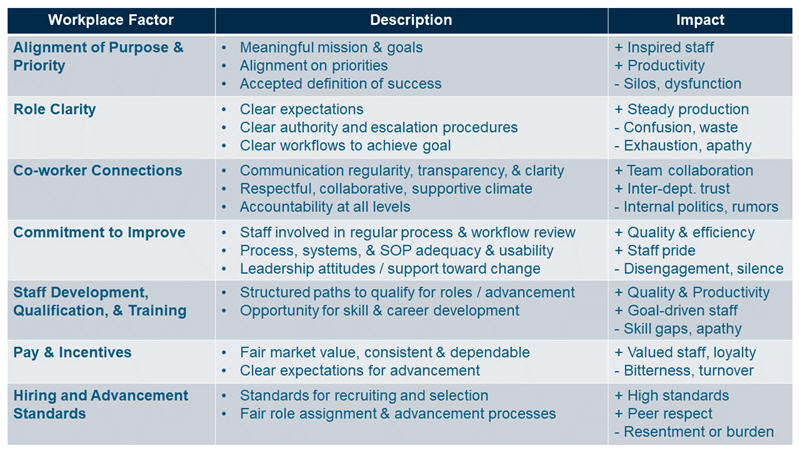Reducing Human Error In Gmp Pharma/Biopharma Operations
By Harry Benson

In the pharmaceutical and biotech industries, delays in getting products to market cost companies revenue and inhibit patient access to their medications. CAI clients often seek help in closing open investigations, but ignore the source of these investigations, even while product sits quarantined. Where clients really need help is in cutting human error off at the source. Industry average deviation costs generally range from $25,000 to $55,000, yet they can top $1,000,000 per deviation if product loss is involved. Investigating one deviation alone can cost a company thousands of dollars. When considering the cost of heroic efforts to produce and release batches, subsequent employee turnover, and potential downtime, cost increases exponentially.
A Human Performance approach leans on structured methods that assess a site’s processes where human error presents the most risk, then implementing solutions that stop these errors at the source. The resulting solutions may be cultural, procedural, or technical in nature, and could fall within any department or workstream of the business where humans are involved. Eliminating deviations, particularly recurring ones, will allow your site to move product to market more quickly and efficiently.
Consider the patient viewpoint when deciding to invest in human error prevention measures. Can you imagine telling a patient you don’t have the medicines they depend on because the people who make your product don’t know, for example, what “verification” or “observed” means when creating a batch record? There is no good reason for patients to be deprived of their medications due to human error.

What are the factors within our organization’s control that impact ongoing human performance?

Organizations need to pay deliberate attention to each of these factors. Since the CEO or Site Head is responsible for the culture of an organization or site, the best approach is for these leaders to assign each of these workplace factors to a primary owner and an executive sponsor who engage the entire organization in the right way to build, and then continually analyze and improve, their assigned factor. But leadership is more than a title or role; it is a mindset backed by action. Thus, improvement initiative in any of these areas can also be sparked from within an organization, provided that leadership encourages it.
1. Alignment on Purpose & Priority. When considering factors impacting human performance, organizational alignment comes first and foremost. Let’s illustrate its importance with a scenario that our teams have observed on multiple occasions:
The Director of Manufacturing states that attention to quality is the most important priority, “Right First Time” is a common cry. However, during certain production runs, we see an uptick in errors. Upon investigation, we learn that the line supervisors were rushing the operators because their production was running behind.
This phenomenon, known as “conflicting priorities”, often leads to confusion and errors. If employees at all levels are aligned, are clear on priorities, and have accepted the definition of success (metrics, for instance), then this setback can be avoided, or at least minimized to a manageable level.
According to FDA inspection observation data, the most common regulatory observations are direct results of human error. While a major risk to error-free work is lack of role clarity (which is our factor #2), problems in this area usually begin with factor one, which is a lack of alignment within leadership and a chaotic organizational structure. This is one of the most difficult problems to solve – not because the solution is difficult, but because it often involves the opinions and egos of the organization’s leaders. In order for consensus to be reached, someone must concede to some degree and still be committed to the organization’s goals and priorities.
2. Role Clarity. An employee’s understanding of his or her role and responsibilities should not be taken for granted upon hire and orientation. Employees deviate from the expected course of action for many reasons, including uncertainty about the situation, the expectation, or the process, or conflicting priorities or distractions, such as multiple, and often unreasonable, expectations from a single job role. Mapping employee workflows effectively allows organizations to build the right SOPs, and qualification and training programs to prepare employees with the system and process knowledge they need to stay true to course.
Since no amount of procedural communication and training can guarantee all operators will respond ideally to all circumstances, role clarity also includes clarifying levels and limits of authority, along with the best escalation and support procedures in case of previously unforeseen situations.
3. Co-worker Connections. Employee workplace interactions with others deeply affect job satisfaction. Most people take a critical or positive comment from a co-worker directly to heart. This is true even if the comment was made innocently while passing in the lunchroom.
Notice that for “communications” we say regular, not prescribing a particular frequency. It’s important that some standard frequency is established and maintained because people can interpret the absence of communication personally as well. Without clear communication, we begin to tell ourselves stories regarding transparency or politics, which can lead to employee mistrust.
A culture of accountability, which is the hallmark of a well-functioning organization, is also formed through employee interactions. The apex of this culture is when peers are able to hold each other accountable without any emotional backlash. To achieve this cultural goal, the first two factors must be well in place (alignment and clear expectations).
4. Commitment to Improve. All organizations have issues and baggage. What matters to employees is how the organization handles these challenges. Do your employees ask themselves: “Is action being taken on the issues I am raising? Isn’t anyone else seeing this problem? Does anyone even care?” If the company lacks a proven record of commitment to continual improvement, not only will people hesitate to raise issues, people will purposely hold back information if they feel no one is listening or acting upon their input.
Much energy is spent on employee engagement programs, and they can be effective in creating a friendly environment and a team attitude. However, these programs will not solve the core issue of a staff that is not engaged in solving business problems. The formula for creating the type of deep engagement that leads to continual improvement and problem solving is simple in concept, but requires humility and for egos to be put aside. The end goal is a genuine culture that first permits, then encourages, and finally recognizes, actions that reveal issues and improve outcomes.
5. Development, Qualification, & Training. In our industries, individuals tend to have a great deal of professional pride, and their performance can be more dependent on their pride in work than strictly on compensation. Therefore, an organization’s demonstrated commitment to the support and development of its employees’ skills and career progression will have a significant and positive effect in the workplace. Conversely, if employees struggle to picture themselves in two to four years in an improved position professionally, then there is high risk of poor performance and turnover.
6. Pay & Incentives. Research continues to show what experience has proven; pay isn’t normally the catalyst for employee performance or departure. Employee pay must be dependable and must meet a fair market value. It’s when pay doesn’t keep pace with the intangibles of the job that people begin weighing their options. They seek compensation that is balanced with the workload and pressures of deadlines and expectations. Of course the structure and equity of pay and promotion also plays a major role in performance. Morale and performance suffer when employees question the legitimacy of the company’s raise or promotion practices.
7. Hiring & Advancement Standards. Like pay, hiring and role selection may not be an initial reason for employees to leave or perform poorly, but if issues in this area continually arise without being addressed, it damages the trust that employees have in an organization and its leaders.
The perspective of each employee must be addressed on a personal level. However, if there is a widespread sense of unfair practices, these types of connections may not be enough. It is also important to keep in mind that if employees sense that the organization has lowered its hiring standards, then existing employees start feeling burdened to pick up the slack. Consistent and fair hiring and selection standards create an environment of peer respect which naturally translate to higher performance standards.
About the Author
 Serving as the Director Human Performance Services at CAI, Harry Benson leads a team of experienced professionals in developing and executing programs, processes, and tools with our clients to standardize and improve the performance of their people. A former nuclear-trained submarine officer and Master Training Specialist, he is an expert in learning solutions design and delivery with over 20 years of experience in applying current methods for organizational effectiveness and learning within highly technical environments. His methods have led to major skill improvement, driving results-based performance for the U.S. Nuclear Navy and companies ranging from small to Fortune 500. Mr. Benson has a Bachelor’s degree from the U.S. Naval Academy, and a Master’s in International Business Administration from Wright State University. He is a specialist in organizational culture and structure, human performance, adult learning, training program development, and data center infrastructure design and operations.
Serving as the Director Human Performance Services at CAI, Harry Benson leads a team of experienced professionals in developing and executing programs, processes, and tools with our clients to standardize and improve the performance of their people. A former nuclear-trained submarine officer and Master Training Specialist, he is an expert in learning solutions design and delivery with over 20 years of experience in applying current methods for organizational effectiveness and learning within highly technical environments. His methods have led to major skill improvement, driving results-based performance for the U.S. Nuclear Navy and companies ranging from small to Fortune 500. Mr. Benson has a Bachelor’s degree from the U.S. Naval Academy, and a Master’s in International Business Administration from Wright State University. He is a specialist in organizational culture and structure, human performance, adult learning, training program development, and data center infrastructure design and operations.
